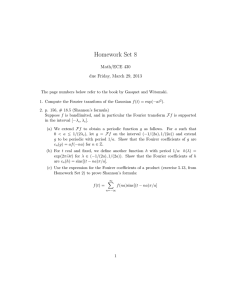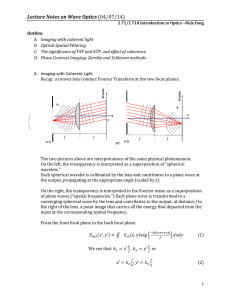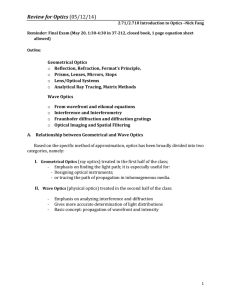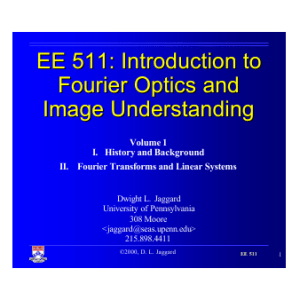Lecture Notes on Wave Optics
advertisement
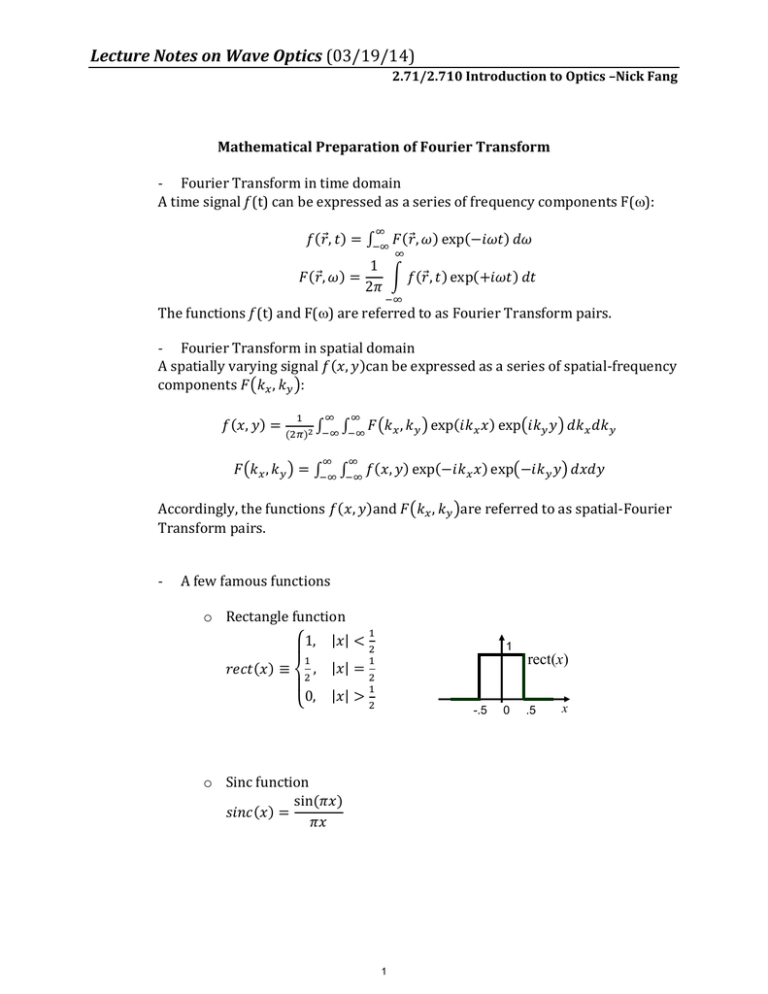
Lecture Notes on Wave Optics (03/19/14)
2.71/2.710 Introduction to Optics –Nick Fang
Mathematical Preparation of Fourier Transform
- Fourier Transform in time domain
A time signal f (t) can be expressed as a series of frequency components F():
∞
𝑓(𝑟⃗, 𝑡) = ∫−∞ 𝐹(𝑟⃗, 𝜔) exp(−𝑖𝜔𝑡) 𝑑𝜔
∞
1
𝐹(𝑟⃗, 𝜔) =
∫ 𝑓(𝑟⃗, 𝑡) exp(+𝑖𝜔𝑡) 𝑑𝑡
2𝜋
−∞
The functions f (t) and F() are referred to as Fourier Transform pairs.
- Fourier Transform in spatial domain
A spatially varying signal 𝑓(𝑥, 𝑦)can be expressed as a series of spatial-frequency
components 𝐹(𝑘𝑥 , 𝑘𝑦 ):
𝑓(𝑥, 𝑦) =
1
(2𝜋)2
∞
∞
∞
∞
∫−∞ ∫−∞ 𝐹(𝑘𝑥 , 𝑘𝑦 ) exp(𝑖𝑘𝑥 𝑥) exp(𝑖𝑘𝑦 𝑦) 𝑑𝑘𝑥 𝑑𝑘𝑦
𝐹(𝑘𝑥 , 𝑘𝑦 ) = ∫−∞ ∫−∞ 𝑓(𝑥, 𝑦) exp(−𝑖𝑘𝑥 𝑥) exp(−𝑖𝑘𝑦 𝑦) 𝑑𝑥𝑑𝑦
Accordingly, the functions 𝑓(𝑥, 𝑦)and 𝐹(𝑘𝑥 , 𝑘𝑦 )are referred to as spatial-Fourier
Transform pairs.
-
A few famous functions
o Rectangle function
|𝑥| <
1
,
|𝑥| =
0,
|𝑥| >
𝑟𝑒𝑐𝑡(𝑥) ≡
1,
2
{
1
1
2
1
rect(x)
2
1
2
-.5
o Sinc function
sin(𝜋𝑥)
𝑠𝑖𝑛𝑐(𝑥) =
𝜋𝑥
1
0
.5
x
Lecture Notes on Wave Optics (03/19/14)
2.71/2.710 Introduction to Optics –Nick Fang
sinc(x)
zeros at x=
np (n ≠ 0)
x
o Triangle Function
1 − |𝑥|,
Λ(𝑥) ≡ {
0,
|𝑥| < 1
|𝑥| ≥ 1
Λ(𝑥)
1
-1
0
1
x
o Step function
1,
1
𝐻(𝑥) ≡ { ,
2
0,
𝑥>0
𝑥=0
𝑥<0
x
o Comb function
∞
𝑐𝑜𝑚𝑏(𝑥) = ∑ 𝛿(𝑥 − 𝑛)
𝑛=−∞
2
Lecture Notes on Wave Optics (03/19/14)
2.71/2.710 Introduction to Optics –Nick Fang
-
Interesting properties of Fourier Transform:
o Scale theorem 𝑓(𝑎𝑥)
F(kx)
f(x)
x
kx
x
kx
x
kx
o Shift theorem𝑓(𝑥 − 𝑎),
(e.g. double slit)
t(x) = rect[(x+a)/w] + rect[(x-a)/w]
t(x)
w
w
0
-a
x
a
o Complex Conjugate 𝑓 ∗ (𝑥)
𝑑
o Derivative
𝑑𝑥
𝑓(𝑥)
3
Lecture Notes on Wave Optics (03/19/14)
2.71/2.710 Introduction to Optics –Nick Fang
2𝜋
o Modulation 𝑓(𝑥)cos(
𝑓(𝑥)cos(
2𝜋
𝐿
𝑥)
𝐹(𝑘𝑥 )
𝑥)
x
-
-G0
𝛿 𝑘−
0
G0
+𝛿 𝑘+
kx
Practice problem: can you apply these theorems in (x, y) plane?
Accordingly, the following functions 𝑓(𝑥, 𝑦)and 𝐹(𝑘𝑥 , 𝑘𝑦 )are referred to as spatialFourier Transform pairs.
Functions
𝑥
𝑟𝑒𝑐𝑡 ( )
𝑎
𝑥
𝑠𝑖𝑛𝑐 ( )
𝑎
𝑥
Λ( )
𝑎
𝑥
comb ( )
𝑎
Gaussian 𝑒𝑥𝑝 (−
𝑥2
𝑎2
Fourier Transform Pairs
𝑎𝑘𝑥
|𝑎|𝑠𝑖𝑛𝑐 (
)
2𝜋
𝑎𝑘𝑥
|𝑎|𝑟𝑒𝑐𝑡 (
)
2𝜋
𝑎𝑘𝑥
|𝑎|2 𝑠𝑖𝑛𝑐 2 (
)
2𝜋
𝑎𝑘𝑥
|𝑎|𝑐𝑜𝑚𝑏 (
)
2𝜋
𝑎2
𝑒𝑥𝑝 (− 𝑘𝑥 2 )
4𝜋
1
1
+ (𝛿(𝑘𝑥 ))
𝑖𝑘𝑥 2
)
Step function 𝐻(𝑥)
2𝜋𝐽1 (𝑎√𝑘𝑥 2 + 𝑘𝑦 2 )
√𝑥 2 + 𝑦 2
𝑐𝑖𝑟𝑐 (
)
𝑎
|𝑎|2
𝑎√𝑘𝑥 2 + 𝑘𝑦 2
4
MIT OpenCourseWare
http://ocw.mit.edu
2SWLFV
Spring 2014
For information about citing these materials or our Terms of Use, visit: http://ocw.mit.edu/terms.
5
